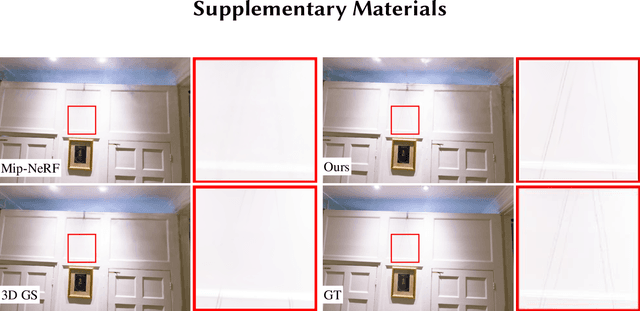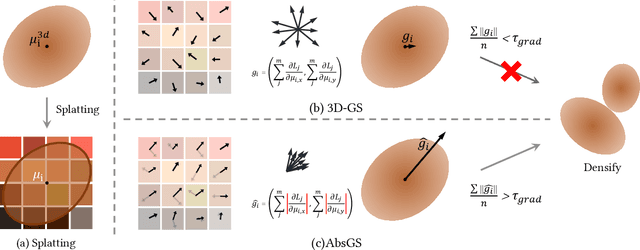Sidun Liu
Mono3R: Exploiting Monocular Cues for Geometric 3D Reconstruction
Apr 18, 2025Abstract:Recent advances in data-driven geometric multi-view 3D reconstruction foundation models (e.g., DUSt3R) have shown remarkable performance across various 3D vision tasks, facilitated by the release of large-scale, high-quality 3D datasets. However, as we observed, constrained by their matching-based principles, the reconstruction quality of existing models suffers significant degradation in challenging regions with limited matching cues, particularly in weakly textured areas and low-light conditions. To mitigate these limitations, we propose to harness the inherent robustness of monocular geometry estimation to compensate for the inherent shortcomings of matching-based methods. Specifically, we introduce a monocular-guided refinement module that integrates monocular geometric priors into multi-view reconstruction frameworks. This integration substantially enhances the robustness of multi-view reconstruction systems, leading to high-quality feed-forward reconstructions. Comprehensive experiments across multiple benchmarks demonstrate that our method achieves substantial improvements in both mutli-view camera pose estimation and point cloud accuracy.
Regist3R: Incremental Registration with Stereo Foundation Model
Apr 16, 2025Abstract:Multi-view 3D reconstruction has remained an essential yet challenging problem in the field of computer vision. While DUSt3R and its successors have achieved breakthroughs in 3D reconstruction from unposed images, these methods exhibit significant limitations when scaling to multi-view scenarios, including high computational cost and cumulative error induced by global alignment. To address these challenges, we propose Regist3R, a novel stereo foundation model tailored for efficient and scalable incremental reconstruction. Regist3R leverages an incremental reconstruction paradigm, enabling large-scale 3D reconstructions from unordered and many-view image collections. We evaluate Regist3R on public datasets for camera pose estimation and 3D reconstruction. Our experiments demonstrate that Regist3R achieves comparable performance with optimization-based methods while significantly improving computational efficiency, and outperforms existing multi-view reconstruction models. Furthermore, to assess its performance in real-world applications, we introduce a challenging oblique aerial dataset which has long spatial spans and hundreds of views. The results highlight the effectiveness of Regist3R. We also demonstrate the first attempt to reconstruct large-scale scenes encompassing over thousands of views through pointmap-based foundation models, showcasing its potential for practical applications in large-scale 3D reconstruction tasks, including urban modeling, aerial mapping, and beyond.
VoxNeuS: Enhancing Voxel-Based Neural Surface Reconstruction via Gradient Interpolation
Jun 11, 2024Abstract:Neural Surface Reconstruction learns a Signed Distance Field~(SDF) to reconstruct the 3D model from multi-view images. Previous works adopt voxel-based explicit representation to improve efficiency. However, they ignored the gradient instability of interpolation in the voxel grid, leading to degradation on convergence and smoothness. Besides, previous works entangled the optimization of geometry and radiance, which leads to the deformation of geometry to explain radiance, causing artifacts when reconstructing textured planes. In this work, we reveal that the instability of gradient comes from its discontinuity during trilinear interpolation, and propose to use the interpolated gradient instead of the original analytical gradient to eliminate the discontinuity. Based on gradient interpolation, we propose VoxNeuS, a lightweight surface reconstruction method for computational and memory efficient neural surface reconstruction. Thanks to the explicit representation, the gradient of regularization terms, i.e. Eikonal and curvature loss, are directly solved, avoiding computation and memory-access overhead. Further, VoxNeuS adopts a geometry-radiance disentangled architecture to handle the geometry deformation from radiance optimization. The experimental results show that VoxNeuS achieves better reconstruction quality than previous works. The entire training process takes 15 minutes and less than 3 GB of memory on a single 2080ti GPU.
DistGrid: Scalable Scene Reconstruction with Distributed Multi-resolution Hash Grid
May 08, 2024



Abstract:Neural Radiance Field~(NeRF) achieves extremely high quality in object-scaled and indoor scene reconstruction. However, there exist some challenges when reconstructing large-scale scenes. MLP-based NeRFs suffer from limited network capacity, while volume-based NeRFs are heavily memory-consuming when the scene resolution increases. Recent approaches propose to geographically partition the scene and learn each sub-region using an individual NeRF. Such partitioning strategies help volume-based NeRF exceed the single GPU memory limit and scale to larger scenes. However, this approach requires multiple background NeRF to handle out-of-partition rays, which leads to redundancy of learning. Inspired by the fact that the background of current partition is the foreground of adjacent partition, we propose a scalable scene reconstruction method based on joint Multi-resolution Hash Grids, named DistGrid. In this method, the scene is divided into multiple closely-paved yet non-overlapped Axis-Aligned Bounding Boxes, and a novel segmented volume rendering method is proposed to handle cross-boundary rays, thereby eliminating the need for background NeRFs. The experiments demonstrate that our method outperforms existing methods on all evaluated large-scale scenes, and provides visually plausible scene reconstruction. The scalability of our method on reconstruction quality is further evaluated qualitatively and quantitatively.
AbsGS: Recovering Fine Details for 3D Gaussian Splatting
Apr 16, 2024



Abstract:3D Gaussian Splatting (3D-GS) technique couples 3D Gaussian primitives with differentiable rasterization to achieve high-quality novel view synthesis results while providing advanced real-time rendering performance. However, due to the flaw of its adaptive density control strategy in 3D-GS, it frequently suffers from over-reconstruction issue in intricate scenes containing high-frequency details, leading to blurry rendered images. The underlying reason for the flaw has still been under-explored. In this work, we present a comprehensive analysis of the cause of aforementioned artifacts, namely gradient collision, which prevents large Gaussians in over-reconstructed regions from splitting. To address this issue, we propose the novel homodirectional view-space positional gradient as the criterion for densification. Our strategy efficiently identifies large Gaussians in over-reconstructed regions, and recovers fine details by splitting. We evaluate our proposed method on various challenging datasets. The experimental results indicate that our approach achieves the best rendering quality with reduced or similar memory consumption. Our method is easy to implement and can be incorporated into a wide variety of most recent Gaussian Splatting-based methods. We will open source our codes upon formal publication. Our project page is available at: https://ty424.github.io/AbsGS.github.io/
Towards Vision Transformer Unrolling Fixed-Point Algorithm: a Case Study on Image Restoration
Jan 29, 2023Abstract:The great success of Deep Neural Networks (DNNs) has inspired the algorithmic development of DNN-based Fixed-Point (DNN-FP) for computer vision tasks. DNN-FP methods, trained by Back-Propagation Through Time or computing the inaccurate inversion of the Jacobian, suffer from inferior representation ability. Motivated by the representation power of the Transformer, we propose a framework to unroll the FP and approximate each unrolled process via Transformer blocks, called FPformer. To reduce the high consumption of memory and computation, we come up with FPRformer by sharing parameters between the successive blocks. We further design a module to adapt Anderson acceleration to FPRformer to enlarge the unrolled iterations and improve the performance, called FPAformer. In order to fully exploit the capability of the Transformer, we apply the proposed model to image restoration, using self-supervised pre-training and supervised fine-tuning. 161 tasks from 4 categories of image restoration problems are used in the pre-training phase. Hereafter, the pre-trained FPformer, FPRformer, and FPAformer are further fine-tuned for the comparison scenarios. Using self-supervised pre-training and supervised fine-tuning, the proposed FPformer, FPRformer, and FPAformer achieve competitive performance with state-of-the-art image restoration methods and better training efficiency. FPAformer employs only 29.82% parameters used in SwinIR models, and provides superior performance after fine-tuning. To train these comparison models, it takes only 26.9% time used for training SwinIR models. It provides a promising way to introduce the Transformer in low-level vision tasks.
Multi-Outputs Is All You Need For Deblur
Aug 27, 2022



Abstract:Image deblurring task is an ill-posed one, where exists infinite feasible solutions for blurry image. Modern deep learning approaches usually discard the learning of blur kernels and directly employ end-to-end supervised learning. Popular deblurring datasets define the label as one of the feasible solutions. However, we argue that it's not reasonable to specify a label directly, especially when the label is sampled from a random distribution. Therefore, we propose to make the network learn the distribution of feasible solutions, and design based on this consideration a novel multi-head output architecture and corresponding loss function for distribution learning. Our approach enables the model to output multiple feasible solutions to approximate the target distribution. We further propose a novel parameter multiplexing method that reduces the number of parameters and computational effort while improving performance. We evaluated our approach on multiple image-deblur models, including the current state-of-the-art NAFNet. The improvement of best overall (pick the highest score among multiple heads for each validation image) PSNR outperforms the compared baselines up to 0.11~0.18dB. The improvement of the best single head (pick the best-performed head among multiple heads on validation set) PSNR outperforms the compared baselines up to 0.04~0.08dB. The codes are available at https://github.com/Liu-SD/multi-output-deblur.
 Add to Chrome
Add to Chrome Add to Firefox
Add to Firefox Add to Edge
Add to Edge